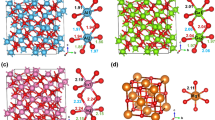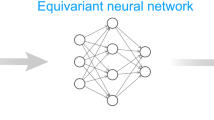Abstract
Some rotaxane molecules were designed, and their electronic capabilities were studied by means of DFT calculations. The original molecular wire consists of an iron complex that comprises aromatic substituents that constitute linear chains, and this system is complemented by the addition of fullerene C60 unities at both extremes of the chain, which act as the stoppers of the chain. Another modification was to add a link that gives way to the mechanical bond; this link is a square molecule of bis-pyrydyl-pyridinium tetraion. An interesting effect was observed as a result of these modifications; the conductivity of the systems rises with the first substitution and even more with the second in such a way that the original semiconductor material changes to give a conductor one.








Similar content being viewed by others
References
Fukui K, Yonezawa T, Shingu H (1952) A molecular orbital theory of reactivity in aromatic hydrocarbons. J Chem Phys 20:722–725
Marcus RA (1964) Chemical and electrochemical electron transfer theory. Annu Rev Phys Chem 15:155–196
Closs GL, Miller JR (1988) Intra-molecular long distance electron transfer in organic molecules. Science 240:440–447
Aviram A, Ratner MA (1974) Molecular rectifiers. Chem Phys Lett 29:277–283
Arrhenius TS, Blanchard-Desce M, Dvolaitzky M, Lehn JM (1986) Molecular devices: caroviologens as an approach to molecular wires-synthesis and incorporation into vesicle membranes. Proc Natl Acad Sci U S A 83:5355–5359
Grozema FC, Siebbeles LDA (2011) Introduction: molecular electronics and molecular wires. Charge and exciton transport through molecular wires. Wiley-VCH, Weinheim
Joachim C, Gimzewski JK, Aviram A (2000) Electronics using hybrid molecular and mono-molecular devices. Nature 408:541–548
Carrol LR, Gorman CB (2002) The genesis of molecular electronics. Angew Chem Int Ed 41:4378–4400
Feynman RP (1960) There’s plenty of room at the bottom. Eng Sci 23:22–36
Wang S, Shan Z, Huang H (2017) The mechanical properties of nano-wires. Adv Sci 4:1600332
Appel D (2002) Wired for success. Nature 419:553–555
Tanaka Y, Kiguchi M, Munetaka A (2017) Inorganic and organometallic molecular wires for single molecule devices. Chem Eur J 23:4741–4749
Van Dongen SFM, Cantekin S, Elemans JAAW, Rowan AE, Nolte RJM (2014) Functional interlocked systems. Chem Soc Rev 43:99–112
Gil-Ramírez G, Leigh DA, Stephens AJ (2015) Catenanes, fifty years of molecular links. Angew Chem Int Ed Eng 54:6110–6150
McConnell AJ, Wood CS, Neelakandan P, Nitschke JR (2015) Stimuli-responsive metal-ligand assemblies. Chem Rev 115:7729–7793
Kottas GS, Clarke LI, Horinek D, Michl J (2005) Artificial molecular rotors. Chem Rev 105:1281–1376
Salcedo R, Monroy O, Ruiz-Espinoza A, Fomina L (2017) Simulation of [2]rotaxane and [2]catenane compounds containing fullerene fragments. Influence of the fullerene moiety. Comp Theo Chem 1102:22–29
Becke AD (1988) Density-functional exchange-energy approximation with correct asymptotic behavior. Phys Rev A 38:3098–3100
Perdew JP, Wang Y (1992) Accurate and simple analytic representation of the electron-gas correlation energy. Phys Rev B 45:13244–13249
Frisch MJ, Trucks GW, Schlegel HB, Scuseria GE, Robb MA, Cheeseman JR, Scalmani G, Barone V, Petersson GA, Nakatsuji H, Li X, Caricato M, Marenich AV, Bloino J, Janesko BG, Gomperts R, Mennucci B, Hratchian HP, Ortiz JV, Izmaylov AF, Sonnenberg JL, Williams-Young D, Ding F, Lipparini F, Egidi F, Goings J, Peng B, Petrone A, Henderson T, Ranasinghe D, Zakrzewski VG, Gao J, Rega N, Zheng G, Liang W, Hada M, Ehara M, Toyota K, Fukuda R, Hasegawa J, Ishida M, Nakajima T, Honda Y, Kitao O, Nakai H, Vreven T, Throssell K, Montgomery JA Jr., Peralta JE, Ogliaro F, Bearpark MJ, Heyd JJ, Brothers EN, Kudin KN, Staroverov VN, Keith TA, Kobayashi R, Normand J, Raghavachari K, Rendell AP, Burant JC, Iyengar SS, Tomasi J, Cossi M, Millam JM, Klene M, Adamo C, Cammi R (2016) Gaussian 16, revision A.03. Gaussian, Inc., Wallingford
Kaliginedi V, Rudnev AV, Moreno-García P, Baghernejad M, Huang C, Hong W, Wandlowski T (2014) Promising anchoring groups for single-molecule conductance measurements. Phys Chem Chem Phys 16:23529–23539
Lissel F, Schwarz F, Blacque O, Riel H, Lörtscer E, Venkatesan K, Berke H (2014) Organometallic single-molecule electronics: tuning electron transport through X(diphosphine)2FeC4Fe(diphosphine)2X building blocks by varying the Fe−X−Au anchoring scheme from coordinative to covalent. J Am Chem Soc 136:14560–14569
Martin CA, Ding D, Sorensen JK, Bjornholm T, Ruitenbeek, van der Zant HS (2008) Fullerene-based anchoring groups for molecular electronics. J Am Chem Soc 130:13198–13199
Kaur RP, Engles D (2018) Transport in a fullerene terminated aromatic molecular device. J Sci: Adv Mat Dev 3:206–212
Fu H, Shao X, Chipot C, Cai W (2017) The lubricating role of water in shuttling of rotaxanes. Chem Sci 8:5087–5094
Acknowledgments
Authors would like to acknowledge Oralia L Jiménez A., María Teresa Vázquez, Alejandro Pompa, Alberto López-Vivas and Caín González for their technical support. The financial support of projects DGAPA PAPIIT IN203816 and RN203816 is also recognized.
Author information
Authors and Affiliations
Corresponding author
Additional information
Publisher’s note
Springer Nature remains neutral with regard to jurisdictional claims in published maps and institutional affiliations.
Rights and permissions
About this article
Cite this article
Salcedo, R., Rios, C., Fomina, L. et al. Rotaxane and pseudo-rotaxane molecules from molecular wires. Theoretical description. J Mol Model 25, 203 (2019). https://doi.org/10.1007/s00894-019-4102-8
Received:
Accepted:
Published:
DOI: https://doi.org/10.1007/s00894-019-4102-8




